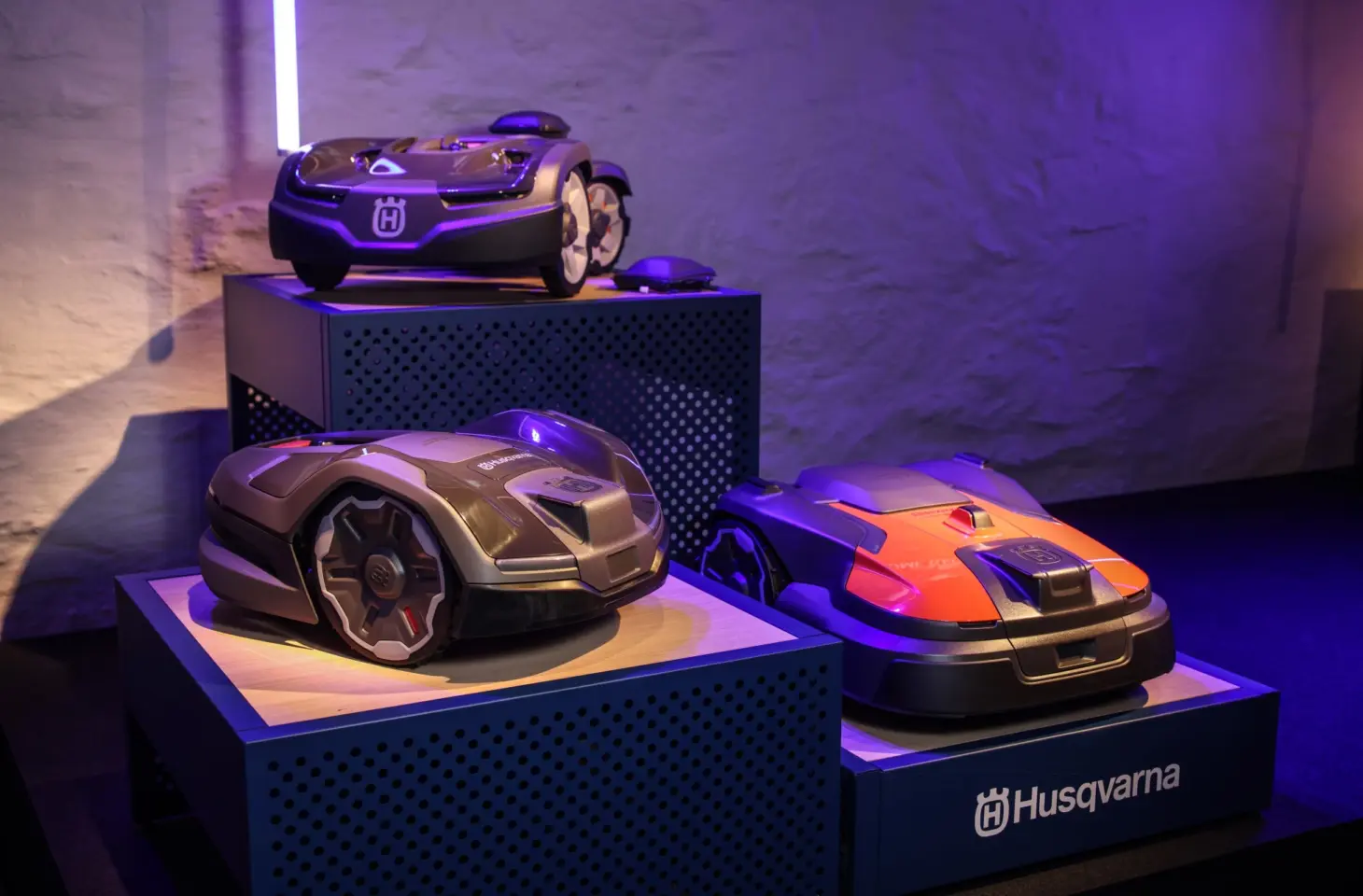For more than three hundred years, Husqvarna has been a household name in Sweden, and for several decades outside the country as well. Manufacturing is in the company’s DNA, but today Husqvarna has emerged as a digital enterprise. Conversations around the water cooler don’t concern production lines or moulds, but Azure, testing and continuous integration. ITdaily heads north to witness the digital transformation firsthand.
Water flows through a massive green pipe from the foothills of the southern Swedish highlands to two electricity turbines several dozen meters below. Today, the turbines supply up to three percent of the town of Jönkoping’s power. More than three hundred years ago, in 1689, the power of that water drove a multitude of waterwheels where we stand today.
The old flour mill building(kvarn) that supplied flour to the local castle (husq) no longer exists, although a new mill has appeared on the exact same spot. It is dwarfed by the immense factory that dominates the foot hills: this is where Husqvarna was born. “Mechanical hydropower was the only form of energy that could power factories back then,” explains Sara Gard, Director of Residential Robotics R&D at Husqvarna.
From guns to mowers
Today Husqvarna has offices and factories worldwide, but the factory in Jönkoping remains important. In a building dating back to the first half of the nineteenth century, we see the twenty-first century in action. Gard and her colleagues present their latest robotic lawn mowers there. The Automower robots have been around for thirty years, transforming not only gardens but the company itself.

“For the first two hundred years of the companies existence, it manufactured weapons,” Gard says. “Out of weapons production grew the manufacture of sewing machines, since that manufacturing process is very similar. Then came bicycles, motorcycles and chainsaws. If you think about it, a motorcycle is basically a chainsaw on wheels,” she laughs.
If you think about it, a motorcycle is basically a chainsaw on wheels.
Sara Gard, Director of Residential Robotics R&D.
Husqvarna is proud of its three-hundred-year history. At the factory is a museum filled with unique pieces, such as Belgian motocross legend Jacky Martens’ motorcycle, muskets from the Swedish army, and a manual lawnmower. That last one is important.
Automower
Gard: “In 1919, we bought a company with a lawn mower in its portfolio. We then fitted it with an engine, creating the first motorized mower of its kind. Later, 1995 we launched the Automower.”
With the Automower, Husqvarna introduced the lawnmower robot. Today in the old building we see an exhibition of a whole portfolio of robots: from ordinary home mowers and 4×4 variants to immense devices tailored to golf courses. Some rely on a wire that demarcates their working domain; others use satellite positioning linked to the cloud.
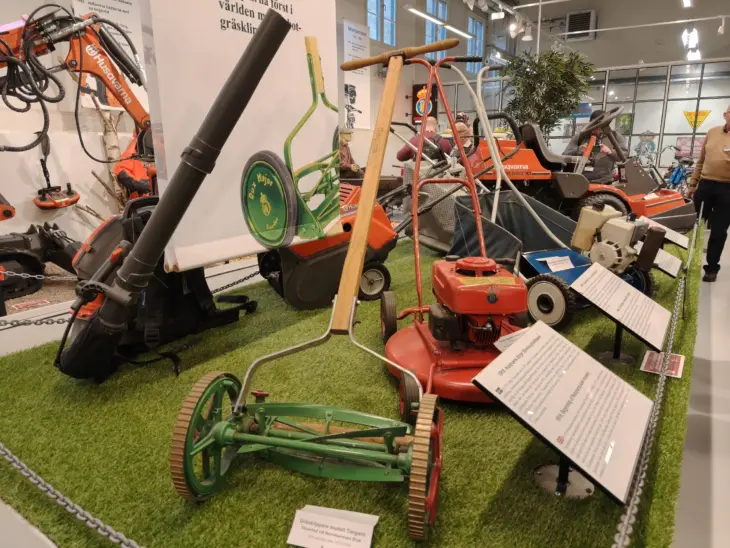

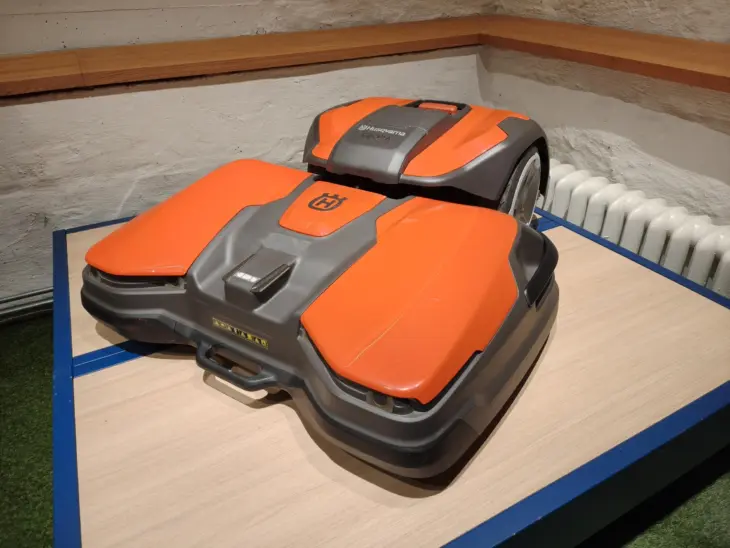
The first version of the Automower was a solar-powered device that cost about 2,000 euros and was unreliable. Despite that unreliability, no one wanted their money back: early customers wanted the thing to work, even if that took some doing. Husqvarna knew then it was on a promising track: the robot was sparking a revolution.
Like sheep
“In fact, we’ve been in the lawn business for more than a hundred years,” says Eric Norling, Director of Product Management Husqvarna Forest & Garden. “We sell robots that, like sheep, are always outside. They do cost a bit, so they have to be robust and keep working. If you have to babysit them, they’re not really autonomous. You should only touch the robots twice a year: to put them outside in the spring, and to bring them back in in the winter.”
To make that possible, the robots must be not only robust but also smart. If they get stuck, escape from the garden or destroy flowerbeds, they are not doing their job properly. “That’s why the digital component is so important,” Norling said.
Today Husqvarna’s robot department has about 80 software developers. They outnumber the hardware engineers. We climb up along a stairway newt to the green water pipe and see to our left the original river with waterfall, along which the water flows. Following the mountain path, we reach a back entrance. We are going to visit the developers in their natural habitat: one of the historic buildings of the Husqvarna factory.
Old factory hall chock-full of robots
Björn Mannefred, Manager of Software Engineering Residential EPAC R&D Robotic, is our guide. Throughout the old building we see more robots than people: some lying naked without enclosures in racks, others driving across simulated lawns. We look through the window at the roof of a neighboring building, on which Automowers are swarming. There is something endearing about it: we understand that many customers treat their robots like pets.

“We work here with small teams of about seven people,” says Mannefred. “And we are all close to each other. For example, a software specialist can immediately ask a colleague from a hardware team if it is possible to provide some more power in the engine.” Such close cooperation is exceptional, he thinks. “At a car manufacturer, you won’t encounter such two-way traffic.”
We pause in front of a screen with a Microsoft Power BI dashboard. On it, we see telemetry from the connected lawnmower fleet. The teams can see at a glance which error messages or problems occur most often, and deserve priority. “We collect only anonymous data, taking into account the GDPR,” Norling emphasizes.
Digital garden
A little further on, a digital robot drives around in a digital garden. Mannefred: “When we send people to the U.S. to test a robot, we don’t want things to get visibly stuck in the corner of a garden because they can’t think of a right way to turn. Such issues have nothing to do with the hardware and we can simulate them beforehand. That’s what happens here.”
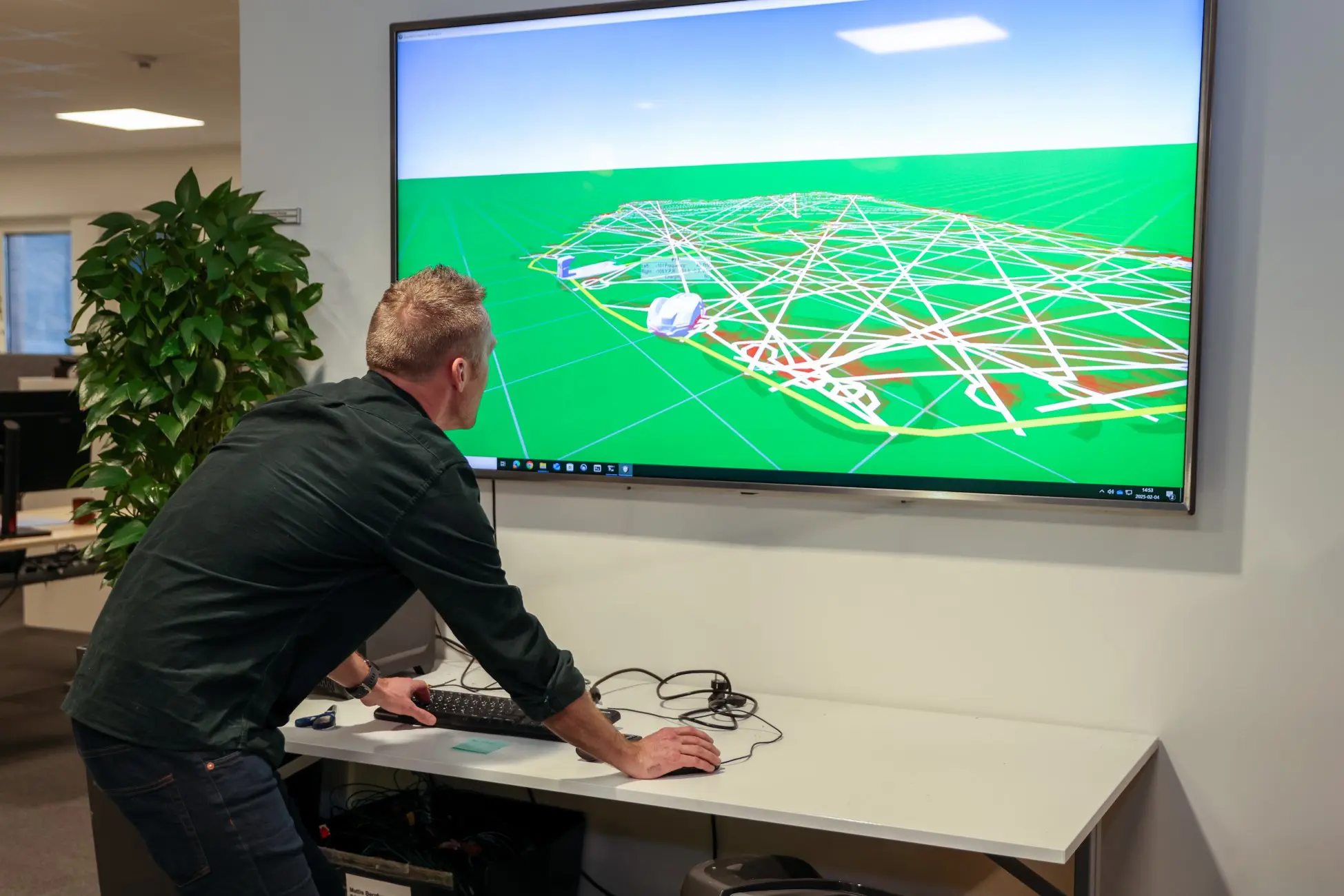
The garden in question is a digital representation of a client’s domain. “The clients have given permission for the usage,” Mannefred notes immediately. “Every two hours we run simulations in a different customer’s garden. The developers see those tests on the screen, although we run more of them in the background. By showing the simulation, we bring the customer close to the developer.”
Continuous integration on artificial grass
A little further on, a robot rides ostentatiously around on a few square meters of artificial turf. Mannefred explains, “We work with continuous integration, where updates from the teams are frequently integrated into the code. Then we upload new firmware to the robots and let them drive for seventeen hours. If something were to go wrong with the code, we risk the robot no longer working. So hardware must always be part of the software testing process.” Hardware in the loop, this process is called.
Hardware should always be part of the software testing process.
Björn Mannefred, Manager of Software Engineering
Only when the robots have performed smoothly with the new firmware is it ready for rollout. Today, that happens via the cloud. In 2019, Husqvarna rolled out the first over-the-air updates. Today, the machines are mostly connected and customers can give them detailed instructions via an app on the smartphone. With AIM(Automower Intelligent Mapping), for example, it is possible to define zones in a garden, and indicate how they should be mowed (or not mowed).
We see agile teams, modern development strategies, computer simulations and testing systems that are all fitting for a modern software company. They realize this at Husqvarna, too. The company is showing off innovation at the Mobile World Congress these days, alongside laptop builders, router manufacturers and cell phone specialists for good reason.
Eyes and a brain
The software functionality developed by Mannefred and his team is an essential part of the robots’ functions. In the near future, Husqvarna plans to focus even more on this. We leave the nest of robots and developers and continue past old stairs and hallways into a modern-looking Experience Center. There, too, is artificial grass. A robot looks at us – literally.
“AI for perception and intelligent behavior is the next step,” explains Patrik Jägenstedt, director of advanced development R&D Robotic & Product AI lab. The Automower on the artificial turf is equipped with a camera. This allows the robot to watch and interpret what it sees.
“The training is not obvious,” Jägenstedt said. “Most datasets with images today are not taken from the right perspective.” Husqvarna needs images from the garden, filmed from the viewing height of an Automower. The company is collecting that data now. “We are having those annotated, training the software.”
Relief for the hedgehogs
The robot in the Experience Center is already behaving in an exemplary manner. Jägenstedt confronts it with different scenarios. On a screen we see what the robot sees, annotated with colors that reveal something about the interpretation.
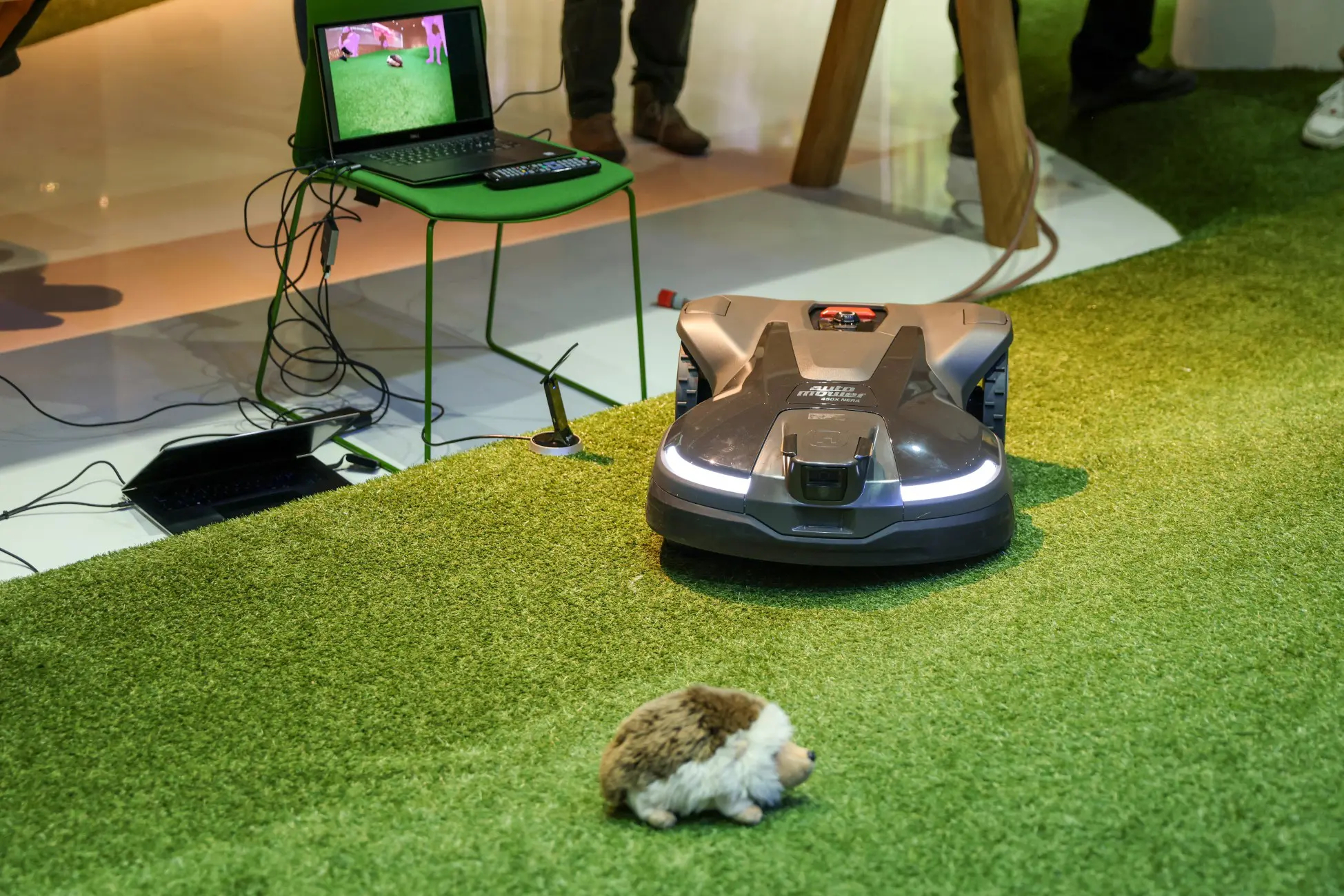
He throws a garden hose in front of the device, which recognizes it as such and neatly dodges it. Next it is the turn of a plush hedgehog that is recognized as an animal. The Automower takes no chances and keeps more distance. That’s good news for baby hedgehogs, which apparently regularly leave for hedgehog heaven from under the blades of Automowers worldwide.
The robot also recognizes people perfectly. That’s not a given, since from its perspective low to the ground it mostly sees legs, and little more. “In time, the robot should be able to make smart decisions based on what it sees,” says Jägenstedt. “For example, if the Automower recognizes a ball in an empty garden, it can push it away by itself. If there are people around, it can decide to take a break since they are likely to be playing.”
Four wheels, blades and an (AI-)accelerator
When we can expect that advanced smart behavior is unclear. Basic computer vision with object recognition is on the menu for the near future, though. By 2026, the lawnmower with camera should leave the experience center toward residential gardens and professional fields worldwide.”
“The lawnmower is not going to send camera images to us or anyone else,” Jägenstedt adds. So those sunbathing in the garden don’t have to hide from the Automower. “All the data is processed on the robot.” A question we never thought to ask forms on our lips: “How many TOPS will the lawnmower have?” Jägenstedt knows the answer: “We are going to integrate an AI accelerator with three to four TOPS of local computing power.”
